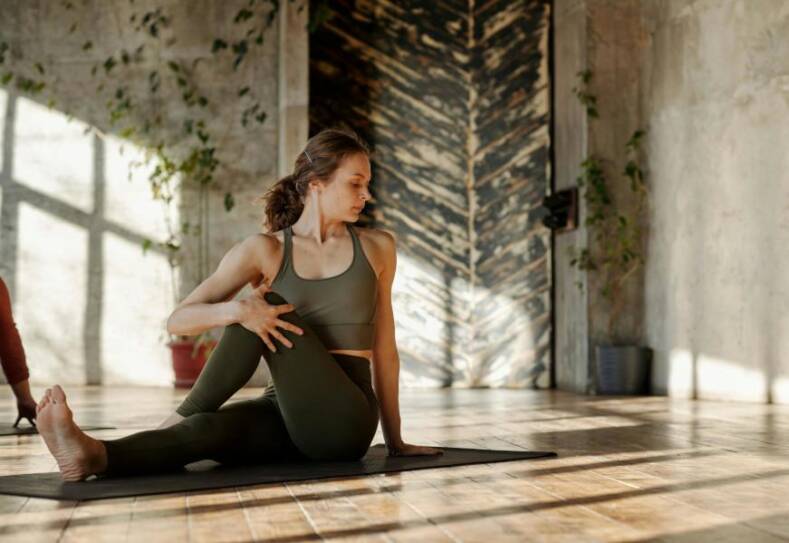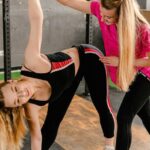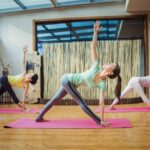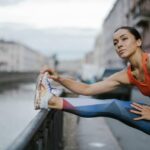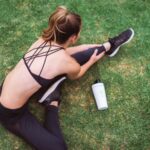Mobility stretches for the full body are essential components of a well-rounded fitness routine, offering significant benefits for flexibility and range of motion. Regular practice of these stretches aids in the reduction of discomfort associated with muscular tightness, while also playing a crucial role in overall physical recovery. Stretching consistently can help individuals attain improved mobility which, in turn, supports their daily activities and enhances athletic performance.

Incorporating a variety of mobility stretches into one’s daily regimen is a proactive approach to maintaining the body’s ability to move freely and efficiently. By targeting all major muscle groups, and ensuring that no area is neglected, the routine works to prevent the development of imbalances that could lead to injury. A full-body mobility program not only supports immediate physical function but also contributes to long-term health and fitness sustainability.
It’s important to note that while flexibility refers to the ability of a muscle to temporarily elongate, mobility is a more comprehensive term that includes the range of motion of joints as well as the ability of the muscles to move freely. Therefore, a well-designed mobility stretch routine is tailored to enhance both aspects, leading to a body that is more resilient and less prone to pain and injury. This becomes particularly valuable as the body ages or recovers from stress and strain.
Understanding Mobility and Its Importance
Mobility is the range of motion within the body’s joints, and it stands as a crucial element for both athletic performance and everyday activities. Proper mobility ensures that individuals can perform movements without restriction, pain, or discomfort.
The Role of Mobility in Athletic Performance
Athletes require exemplary mobility to achieve optimal performance in their respective sports. Mobility facilitates fluid, efficient, and powerful movements, which can be the distinguishing factor between average and peak achievements. For instance, mobility in a swimmer’s shoulders enables a fuller stroke, while a gymnast relies on hip and spine mobility for complex routines. Restricted mobility, on the other hand, could lead to compensatory movements, potentially increasing the risk of injury.
How Daily Routines Influence Flexibility and Mobility
Daily routines can have a significant impact on an individual’s flexibility and mobility. A sedentary lifestyle, characterized by prolonged sitting or inactivity, often leads to decreased mobility, especially in the thoracic spine and hips. These limitations can interfere with basic functional movements like squatting and reaching, highlighting the importance of incorporating mobility exercises into daily routines.
Connecting Mobility with Overall Well-being
Mobility is intricately linked with an individual’s overall well-being. Adequate mobility contributes to a healthier life by preventing injuries, maintaining functional independence, and enhancing physical capabilities. It’s a foundational aspect that influences everyday tasks such as bending, walking, and lifting. Improving mobility translates to improved quality of life, as one can perform daily activities with ease and confidence.
Fundamentals of Effective Stretching
Effective stretching is a cornerstone of overall mobility and flexibility. It involves techniques that warm up the body, promote muscle elasticity, and aid in recovery.
Differentiating Static and Dynamic Stretches
Static stretching involves holding a stretch for a sustained period, typically between 15 to 60 seconds. It is most effective when the muscles are already warm, making it a suitable choice for a cool-down routine. Static stretches aim to increase flexibility and relax the muscles.
- Example of Static Stretch: Sitting hamstring stretch for 30 seconds.
Dynamic stretches, in contrast, involve movement and are used to prepare the muscles for activity. These stretches are performed for 10 to 15 repetitions, promoting blood flow and preparing the muscle groups for the demands of physical activity.
- Example of Dynamic Stretch: Leg swings to promote hip mobility before a run.
The Physiology of Muscle Stretching
Muscle stretching enhances flexibility by elongating the muscle fibers, increasing their range of motion. This action can help prevent injuries and improve postural balance. Stretching activates the muscle’s proprioceptors, which signal the central nervous system to temporarily reset the muscle’s length to a newly established range.
- Physiological Response: Gains in flexibility may occur due to increased tolerance to the stretch sensation over time.
Incorporating Warm-ups and Cool-downs into Stretching
A warm-up should precede dynamic stretches to gradually raise the body temperature and reduce stiffness. This phase can include light aerobic exercises like jogging that target major muscle groups and increase heart rate.
- Warm-up Activity: 5-minute light jog.
The cool-down phase, on the other hand, typically involves static stretching. This helps in recovery by facilitating the removal of lactic acid buildup and reducing muscle soreness.
- Cool-down Activity: Static stretches held for 30 seconds each to relax the muscles after exercise.
Targeted Stretches for Upper Body
To enhance mobility and relieve tension, it’s important to focus on specific stretches that target the upper body’s muscle groups, namely the shoulders, neck, chest, upper back, arms, and abs. These stretches facilitate a full range of motion and contribute to overall upper body health.
Stretching Techniques for Shoulder and Neck
- Shoulder Shrugs and Rolls: Start by shrugging the shoulders upward towards the ears and then rolling them in a circular motion, repeating several times. This aids in relieving tension around the neck and upper shoulders.
- Neck Side Stretch: Tilt the head to one side, bringing the ear towards the shoulder, and hold. This stretch should be felt along the side of the neck and shoulder, promoting flexibility and reducing stiffness.
Chest and Upper Back Expansion Stretches
- Doorway Chest Stretch: Standing in a doorway, place forearms against the door frame with elbows at shoulder height. Lean forward until a stretch is felt across the chest. This helps open up the pectoral muscles.
- Cat-Cow Stretch: On hands and knees, alternate between arching the back upwards (Cat) and dipping it towards the floor (Cow), which loosens the upper back and chest region.
Arms and Abdominal Muscles Stretches
- Triceps Stretch: Raise one arm overhead, bend the elbow to touch the opposite shoulder blade, and use the other hand to gently press the elbow down. This will stretch the triceps and the back of the upper arm.
- Standing Side Reach: Extend one arm overhead and lean to the opposite side to stretch the lateral abs and arm. Hold for a few breaths, and then switch sides, ensuring the abdominal muscles and obliques are targeted.
Essential Stretches for the Lower Body

Stretching the lower body is crucial for maintaining flexibility and mobility. This section focuses on key stretches targeting the hamstrings, quadriceps, hips, glutes, lower back, and calves.
Hamstring and Quadriceps Stretching
For the hamstrings, a simple stretch involves sitting with one leg extended and the other bent, foot resting against the inner thigh. Lean forward from the hips with a straight back to feel a stretch along the back of the thigh. Each stretch should be held for 15-30 seconds, and then repeated with the other leg.
Quadriceps stretching can be performed standing up. Hold onto a stable surface for balance, bend one knee and bring the heel towards the glutes. Grasp the ankle with the hand and gently pull to feel a stretch down the front of the thigh. Maintain this position for 15-30 seconds before switching legs.
Hip Flexor and Gluteal Muscles Mobility
To stretch the hip flexors, one can perform a lunge with a slight twist. Step forward into a lunge and lower the hips toward the ground, keeping the back straight and the forward knee above the ankle. For a deeper stretch, raise the arm on the same side as the back leg and lean slightly to the opposite side. Hold for 15-30 seconds and then switch.
For the glutes, sitting on a flat surface is ideal. Cross one leg over the other so that the ankle rests on the opposite knee, creating a figure four shape. Gently lean forward, maintaining a straight back, until there’s a stretch in the buttock area. Again, a 15-30 second hold is recommended before switching legs.
Lower Back and Calf Stretches
Maintaining lower back health can be achieved with gentle stretches. Lying on one’s back, knees pulled to the chest, and gently rocking side to side will stretch the lower back and alleviate tension.
Calf stretches are essential, especially for those who run or walk frequently. Facing a wall, extend one leg back and press the heel down towards the ground while leaning into the wall. There should be a stretch in the calf muscle of the extended leg. Keep the heel on the ground and the leg straight; hold for 15-30 seconds before changing sides.
Stretches for Enhancing Core Strength and Posture
Enhancing core strength and posture through targeted stretching helps alleviate back pain and reduces stiffness. By focusing on the abdominal, oblique muscles, and lower back, individuals can build a foundation of strength that supports a healthy, upright posture.
Reinforcing Abdominal and Oblique Muscles
Pelvic Tilts:
- Purpose: Strengthen the abdominal muscles and improve lower back stability.
- How-to:
- Lie on your back with your knees bent and feet flat on the floor.
- Flatten your lower back against the floor by gently contracting your abdominal muscles and tilting your pelvis upward.
- Hold for 3-5 seconds, then release.
- Repeat 8-10 times.
Bicycle Crunches:
- Purpose: Target the oblique muscles for improved core strength and better posture.
- How-to:
- Lie on your back with hands behind your head, and knees drawn into your chest.
- Lift your shoulder blades off the floor and straighten one leg out while turning your upper body to bring the opposite elbow toward the bent knee.
- Alternate sides in a pedaling motion.
- Perform 10-12 repetitions on each side.
Lower Back Stability Exercises
Bird-Dog:
- Purpose: Build lower back and core strength to support a robust posture.
- How-to:
- Begin on hands and knees with a neutral spine.
- Extend one arm and the opposite leg simultaneously, keeping your balance and a straight line from fingertips to toes.
- Hold for a few seconds, then return to the starting position and switch sides.
- Aim for 8-12 repetitions on each side.
Child’s Pose to Cobra Stretch:
- Purpose: Stretch and strengthen the lower back muscles.
- How-to:
- Start in Child’s Pose with your arms extended and hips back on your heels.
- Slide forward to lie on your stomach, hands under shoulders.
- Gently press into your hands to lift your chest for the Cobra Stretch, engaging your back muscles.
- Hold for 15-30 seconds, then return to Child’s Pose.
- Repeat 3-5 times.
Incorporating these exercises into a regular stretching routine can significantly contribute to a person’s core strength and posture maintenance.
Special Considerations in Stretching

Stretching routines are not one-size-fits-all and should be adjusted based on individual concerns such as injury prevention, pain management, fitness levels, and demographic differences like gender and age.
Preventing Injury and Pain Management
When incorporating stretches into a fitness regimen, preventing injury is paramount. A person should always warm up with dynamic stretches to prepare muscles for activity. Static stretches can be incorporated post-workout to aid in flexibility and to alleviate muscle tension. Physical therapists often recommend gentle stretching combined with proper techniques to manage pain and prevent the overextension of muscles.
Tailoring Stretches to Different Fitness Levels
Fitness levels vary widely from beginner to advanced, and stretching routines must be adapted accordingly. A personal trainer can design a program with an intensity and complexity that matches an individual’s abilities and goals. Beginners might start with simple stretches, reducing the risk of injury by ensuring the body adapts gradually. More experienced individuals may introduce PNF (Proprioceptive Neuromuscular Facilitation) stretching to improve both flexibility and strength.
Stretching for Specific Groups: Gender and Age Differences
Gender and age may result in differing flexibility and mobility requirements. Men typically have less flexibility than women and may need a longer duration for each stretch to see improvements. As individuals age, joints and muscles tend to lose some of their elasticity, which necessitates a focus on safe, low-impact stretching techniques. Both men and women as they grow older might find value in incorporating balance-focused stretches to maintain joint health and mobility.
Stretching Routines and Structures

Structuring a full-body stretching routine revolves around the inclusion of all major muscle groups and the appropriate sequence of each stretch for optimal recovery and enhanced performance.
Creating a Full-Body Stretch Routine
A full-body stretch routine should be meticulously crafted to cover each major muscle group. This ensures a harmonious development of flexibility across the body and reduces the risk of creating imbalances that could hamper mobility and performance. The structure should be as follows:
Sequence of Stretches:
- Neck and Shoulders: Start with gentle neck rolls and shoulder stretches to release tension from the upper body.
- Arms and Wrists: Progress to arm circles and wrist flexion/extension to prepare the upper limbs.
- Back and Torso: Include stretches like cat-cow and torso twists to enhance spinal mobility.
- Hips and Glutes: Move on to hip circles and glute bridges, focusing on the pelvic area.
- Legs: Incorporate hamstring stretches, quad stretches, and calf raises.
- Ankles and Feet: Finish with ankle circles and toe points to fully engage the lower extremities.
Incorporating dynamic stretches during warm-up and static stretches in the cooldown can maximize muscle preparation and recovery, respectively.
Daily Stretching for Sustainable Mobility
Incorporating daily stretching into one’s routine is a key factor in maintaining and improving overall mobility. A daily regimen ensures muscles and joints remain fluid, responsive, and less prone to injury, thereby consistently supporting physical performance.
Components of Daily Stretching:
- Dynamic Stretches: Include in morning or pre-workout routines to awaken the muscles.
- Static Stretches: Best performed post-workout or before bed for deeper muscle relaxation.
Daily stretching should last at least 5 to 10 minutes, focusing on holding each stretch for 20 to 30 seconds to benefit muscle recovery and flexibility. Regular stretching can improve blood flow, boost recovery, and enhance overall well-being.
Additional Resources and Professional Guidance
In the pursuit of a comprehensive mobility stretches full body routine, individuals may amplify their results through the integration of specialized tools and expert-led fitness programs. These resources can cater to specific needs, potentially enhancing the effectiveness of each stretch.
Utilizing Foam Rollers and Other Tools
Incorporating tools such as foam rollers into a mobility routine can aid in releasing muscle tightness and improving blood flow. They are especially effective for self-myofascial release, a technique that applies gentle, sustained pressure to the connective tissues to eliminate pain and restore motion.
- Foam Rollers: Versatile for various exercises targeting all major muscle groups.
- Massage Balls: Helpful for pinpointing specific areas, such as the shoulders or feet.
Sample Routine with Tool:
- Back Roll: Position the foam roller under your mid-back and gently roll towards the upper back, avoiding the lower back area.
- Hamstring Roll: Sit with the foam roller under your thighs, and roll from the back of your knees up to your glutes.
Exploring Yoga and Professional Fitness Programs
Engaging in yoga can complement a full-body mobility routine. Yoga typically includes a range of postures and stretches that can greatly improve flexibility and balance. For personalized instruction, working with a personal trainer or enrolling in a fitness program ensures that exercises are performed correctly and effectively.
- Yoga: A holistic approach to flexibility, strength, and mental focus.
- Personal Trainers: They provide tailored routines and corrections on form.
Yoga Poses for Mobility:
- Downward-Facing Dog: Stretches the hamstrings, calves, and back.
- Warrior II: Enhances hip mobility and leg strength.
